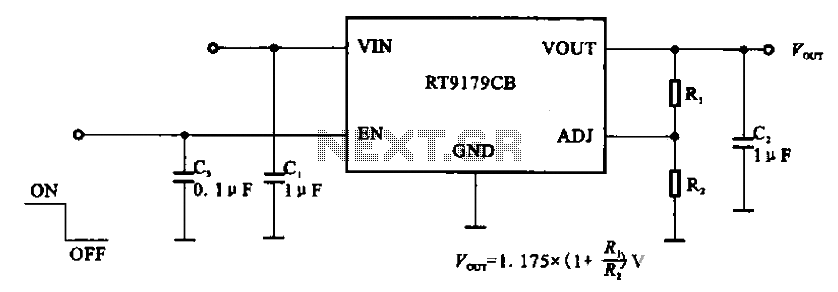
Quiz Circuit

This design utilizes four integrated circuits (ICs) and features four input circuits with four independent outputs, along with a single master reset switch. The outputs are configured with light-emitting diodes (LEDs), which can be modified to control lamps or buzzers. Only one output LED can be illuminated at any given time. The first input switch pressed—either A, B, C, or D—will activate the corresponding output LED while disabling the other inputs. The circuit employs all complementary metal-oxide-semiconductor (CMOS) ICs, with part numbers indicated in the accompanying diagram. The supply voltage can range from 3 to 15 volts and may alternatively utilize equivalent transistor-transistor logic (TTL) ICs powered at 5 volts. The primary component of this circuit is a bistable latch, implemented using a dual 4013 D-type flip-flop. Engaging the reset switch clears all flip-flops and extinguishes any illuminated LEDs. In this state, all Q outputs will be low (logic 0), while all NOT Q outputs will be high (logic 1). The four NOT Q outputs are connected to a four-input AND gate (4082), which will also output high. The output of the 4082 is linked to one input of each of the two-input AND gates (4081). The input switches A, B, C, and D are non-latching push-button switches; the first switch pressed will cause the corresponding AND gate (4081) to output high and trigger the preset input of the 4013 D-type flip-flop. This action will latch and illuminate the appropriate LED. Additionally, the triggered flip-flop will have its NOT Q output set to low, changing the 4082 output to low and preventing any further triggering of the other flip-flops. Switch contact debouncing is unnecessary since the first press will latch one of the bistables. Pressing the reset switch restores the circuit to its initial state. It is advisable to use heavy-duty push-button switches, as they may experience significant stress during operation.
The schematic design includes a power supply section capable of accommodating a voltage range from 3 to 15 volts, ensuring versatility in the choice of components. The use of CMOS technology allows for low power consumption and high noise immunity, making it suitable for battery-operated devices. The core of the design is the dual 4013 D-type flip-flop, which serves as a bistable latch. This flip-flop is crucial for maintaining the state of the output LEDs based on user interaction with the input switches.
The four input switches are connected to the two-input AND gates (4081) that receive signals from the four-input AND gate (4082). The logic flow ensures that only one LED can be activated at a time, providing a clear visual indication of which switch has been pressed. The reset function is integrated into the circuit through a dedicated switch that, when activated, resets all flip-flops and extinguishes the LEDs, returning the circuit to its idle state.
The design also incorporates a simple yet effective mechanism to prevent multiple inputs from being registered simultaneously, enhancing the reliability of the circuit. The heavy-duty push-button switches recommended for this design are essential for ensuring long-term durability and performance, especially in applications where the switches may undergo frequent use. Overall, this circuit provides a straightforward and efficient solution for applications requiring single-output control from multiple inputs, with the flexibility to adapt the output devices as needed.This design uses four IC`s and has four input circuits and four independent outputs and a single master reset switch. The outputs here are LED`s but may be modified to drive lamps or buzzers. Only one output LED can be lit at any time. The first person to press their input switch, A, B, C, D will light the corresponding output LED, disabling the other inputs.
The circuit uses all CMOS IC`s part numbers shown on the diagram. The supply voltage may be anything between 3 and 15 volts. Alternatively, it may be built using equivalent TTL IC`s and powered on 5 volts. The main component in this circuit is a bistable latch, here it is based on the dual 4013 D-type flip flop. Pressing the reset switch will clear all flip flops and extinguish any lit LED`s. Under this condition the Q outputs will all be low (logic 0) and NOT Q outputs will be high (logic 1).
All four NOT Q outputs are fed to a 4 input AND gate, the 4082 whose output will also be high. The output of the 4082 is wired to one input of each 2 input AND gate (4081). Switch inputs A, B, C, D are all non latching push button switches, the first person to press their switch will cause the corresponding AND gate (4081) to go high and trigger the preset input of the 4013 D-type flip flop. This will latch and light the appropriate LED. Also the triggered flip flop will have its NOT Q output, set at low, this changes the 4082 output to low and prevents any further triggering of the other flip flops.
Switch contact de-bouncing is not required as the first press will latch one of the bistables. Pressing the reset switch, restores the circuit to its former state. I would recommend using heavy duty push button switches, as in use they are likely to be under some stress. 🔗 External reference
The schematic design includes a power supply section capable of accommodating a voltage range from 3 to 15 volts, ensuring versatility in the choice of components. The use of CMOS technology allows for low power consumption and high noise immunity, making it suitable for battery-operated devices. The core of the design is the dual 4013 D-type flip-flop, which serves as a bistable latch. This flip-flop is crucial for maintaining the state of the output LEDs based on user interaction with the input switches.
The four input switches are connected to the two-input AND gates (4081) that receive signals from the four-input AND gate (4082). The logic flow ensures that only one LED can be activated at a time, providing a clear visual indication of which switch has been pressed. The reset function is integrated into the circuit through a dedicated switch that, when activated, resets all flip-flops and extinguishes the LEDs, returning the circuit to its idle state.
The design also incorporates a simple yet effective mechanism to prevent multiple inputs from being registered simultaneously, enhancing the reliability of the circuit. The heavy-duty push-button switches recommended for this design are essential for ensuring long-term durability and performance, especially in applications where the switches may undergo frequent use. Overall, this circuit provides a straightforward and efficient solution for applications requiring single-output control from multiple inputs, with the flexibility to adapt the output devices as needed.This design uses four IC`s and has four input circuits and four independent outputs and a single master reset switch. The outputs here are LED`s but may be modified to drive lamps or buzzers. Only one output LED can be lit at any time. The first person to press their input switch, A, B, C, D will light the corresponding output LED, disabling the other inputs.
The circuit uses all CMOS IC`s part numbers shown on the diagram. The supply voltage may be anything between 3 and 15 volts. Alternatively, it may be built using equivalent TTL IC`s and powered on 5 volts. The main component in this circuit is a bistable latch, here it is based on the dual 4013 D-type flip flop. Pressing the reset switch will clear all flip flops and extinguish any lit LED`s. Under this condition the Q outputs will all be low (logic 0) and NOT Q outputs will be high (logic 1).
All four NOT Q outputs are fed to a 4 input AND gate, the 4082 whose output will also be high. The output of the 4082 is wired to one input of each 2 input AND gate (4081). Switch inputs A, B, C, D are all non latching push button switches, the first person to press their switch will cause the corresponding AND gate (4081) to go high and trigger the preset input of the 4013 D-type flip flop. This will latch and light the appropriate LED. Also the triggered flip flop will have its NOT Q output, set at low, this changes the 4082 output to low and prevents any further triggering of the other flip flops.
Switch contact de-bouncing is not required as the first press will latch one of the bistables. Pressing the reset switch, restores the circuit to its former state. I would recommend using heavy duty push button switches, as in use they are likely to be under some stress. 🔗 External reference
